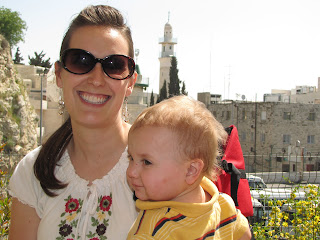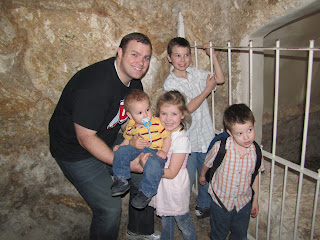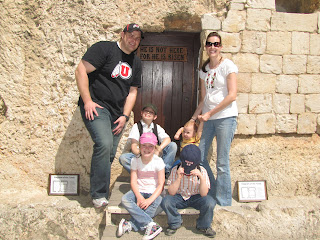I couldn't wait to get one of these hand carved Nativity's but the store owners wanted way to much for them in Jerusalem. Chris made it his business to get me this one on our 3 day in the Old city. The store owner wanted 750 shekles and in the end we talked him down to 300. I plan to keep it up all year long since we are in Israel!
My menorah.
One of the oldest symbols of the Jewish faith is the menorah, which is a seven branched candelabrum that was used in the Temple. The high priest would lite the menorah every evening and clean it out and replace the olive oil every morning.
"It has been said that the menorah is a symbol of the nation of Israel and our mission to be "a light unto the nations." (Isaiah 42:6). The sages emphasize that light is not a violent force; Israel is to accomplish its mission by setting an example, not by using force. This idea is highlighted in the vision in Zechariah 4:1-6. Zechariah sees a menorah, and God explains: "Not by might, nor by power, but by My spirit." "
This was my first souvenir purchase. The Seder plate that they use on"Pesach" passover. We had a Relief Society activity where we ate passover food and learned about the meaning and the tradition.
I find it such a beautiful holiday ( if not a little eccentric :))
Pesach meaning to pass over or to spare. It refers to the fact that God passed over the houses of the Jews as the destroying angel slew the first born of the Egyptians. It is also a seven day celebration of the Exodus from Egypt after generations of slavery.
The customs:
The Jews are not allowed to eat chametz during these 7 days which is the 5 major grains (wheat, rye, barley, oats, and spelt) that has not been completely cooked within 18 minutes after first coming in contact with liquid. Which would be considered leaven.
The Jews start preparing for Pesach a week before, it requires extensive planning and cleaning. They are required to sale or get rid of any utensils that would have come in contact with chametz- leaven bread. Any chametz in the home has to be given away or destroyed. Which includes flour, bread, cookies, pasta,cereal, anything that even could possibly contain chametz. (These things are also not sold for the week of passover so I had to stock up on bread and freeze it)
The kitchen is scrubbed down meticulously even requiring a toothbrush for corners, everything has to be washed down everything!
Then they use separate dishes that have been stored to prevent anything chametz to have come in contact with them. The oven has to be covered in aluminum foil so that the new pans wont touch anything leaven that might have touched the grates. It is also heated to the hottest temperature for 2 hours until the metal has a reddish glow insuring that chametz has been burned away.
They eat Matzah unleavened bread for the week of passover which is simply matzah flour and water that is baked within 18 minutes of combining ingredients. If it goes over the time it is thrown away and they use new dishes and start over since it is believed that after the 18 minutes the bread becomes leaven. This symbolizes the Exodus for Egypt because they didn't have time to let their bread rise so they ate unleavened bread.
Now during the Seder dinner they tell the story of the Exodus and explain the symbols of the Seder plate.
1.Karpas (parsley) is eaten by dipping into salt water which symbolizes the tears shed during the slavery to the Egyptians.
2. Zeroa (Shank bone) a piece of meat and bone symbolizing the sacrificial lamb offered in the Temple on Pasach
3. Baytzah (egg) the egg is a symbol of mourning, Jews are morning the loss of their temple and the loss of the ability to offer sacrifice there for the Pasach holiday.
4.Haroseth is a mixture of apple, nuts, wine (grape juice) and spices it is thick and symbolizes the mortar made by the slaves to build Egyptian structure.
5.Maror (horse radish 1st bitter herb) reminds us of the bitterness of slavery. The horse radish is suppose to be hot enough to bring tears to your eyes.
6. Hazeret (Bitter vegetable 2nd bitter herb) This is usually Romaine lettuce which is considered bitter because of the root. Same meaning as #5
There is a lot more to this holiday but these are the things that I remember.
This is my Armenian pottery. A lot of people don't know that the Old City is made up of 4 different sections, the Muslim section, The Jewish section, the Christian Section, and the Armenian section. My souvenirs are from 3 out of the 4. The Nativity- Christian, Seder and Menorah- Jewish, and my bowl- Armenian. Now I just need something Muslim.




















































